The Shehnai of Bismillah Khan
Bismillah Khan
Please post your attendance here
LEARNING OUTCOMES
STUDENTS YOU WILL BE ABLE TO:
1. Comprehend the text and outline the theme of the chapter
2 Use new words in writing skills.
The day before,we understood the story of Bismillah Khan, now let us dig deeper into this chapter for better understanding.
Students kindly note
The text is written in black
Explanation is written in red
Word meanings (to be done in notebook)are in blue
Introduction to the lesson
The lesson is about Ustaad Bismillah Khan. He was a renowned shehnai player in India. He is a legend because he did something which has historical significance. He played the shehnai on the day India got independence i.e 15th August 1947. At the Red Fort, before the Prime Minister of India, Pandit Jawahar Lal Nehru gave his speech. Before that Bismillah Khan played the shehnai in order to signify something auspicious. Something auspicious for the whole country was about to happen - India was about to get freedom. And so, on that occasion, Bismillah Khan played the shehnai and so, he is a legend.
Lesson and Explanation
EMPEROR
Aurangzeb banned the playing of a musical instrument called pungi in
the royal residence for it had a shrill unpleasant sound.
banned: prohibited
shrill: very sharp
unpleasant: something that you dislike
Pungi
was a musical instrument, the predecessor of the shehnai. When the
Mughals ruled India, before the Britishers came, there was a very famous
Mughal ruler named Aurangzeb. He did not allow the pungi be played in
his royal residence because he felt that it had a shrill, unpleasant
sound.
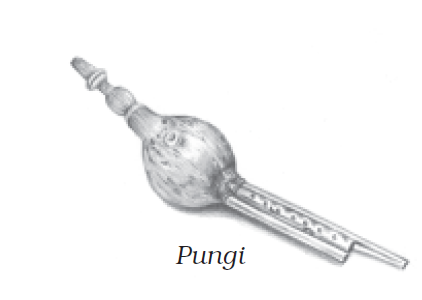
Pungi became the generic name for reeded noisemakers.
generic name: a name given to a class or group as a whole
Generic name means the scientific name or a broad classification of something
reeded: wind instruments which have reeds like the flute, the clarinet, etc.
So,
any musical instrument which is made with reeds like we have flutes,
clarinets, they all are classified as ‘pungi’. So pungi is a broad term
for any type of instrument which uses wind to produce sound.
Few had thought that it would one day be revived.
revived: brought back to live.
As
Aurangzeb has banned all these reeded noisemakers, he had banned pungi
in his royal residence, no one thought that one day such noisemakers,
such instrument which made unpleasant sound would be played and their
sound would be liked by the audience.
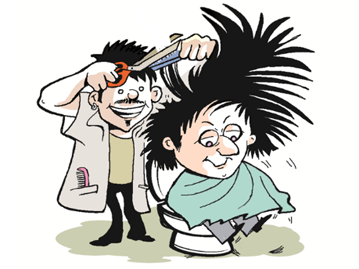
A
barber of a family of professional musicians, who had access to the
royal palace, decided to improve the tonal quality of the pungi.
tonal quality: sound
As
the pungi had an unpleasant sound, there was a barber who belonged to a
family of professional musicians and he wanted to play the pungi but he
knew that the sound produced by pungi was unpleasant and so, he decided
to improve the sound.
He
chose a pipe with a natural hollow stem that was longer and broader
than the pungi, and made seven holes on the body of the pipe.
hollow: empty from inside.
This
barber took a pipe, a pipe which was a hollow stem. It was longer and
broader than the pungi. He made seven holes on the body of the pipe. (If
you have seen a flute it is something like this. It is a pipe which is
hollow from inside and has holes on it.)
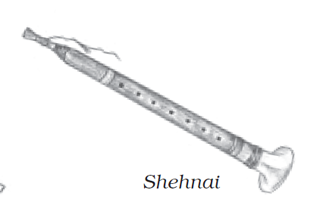
When he played on it, closing and opening some of these holes, soft and melodious sounds were produced.
Then
he blew air into the pipe and closed and opened different holes. He
found that soft and melodious sounds were produced when he did like
this.
He played the instrument before royalty and everyone was impressed.
When the barber played this instrument in the royal court, everyone liked the sound produced by it.
The instrument so different from the pungi had to be given a new name.
The royal court thought that this instrument was different from the pungi and so, it should have a different name also.
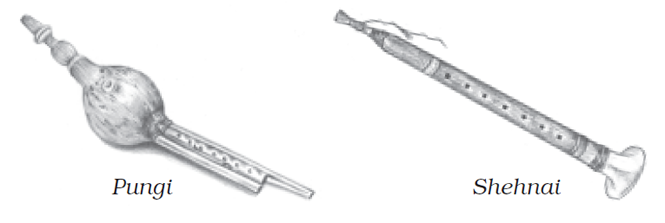
As
the story goes, since it was first played in the Shah’s chambers and
was played by a nai (barber), the instrument was named the ‘shehnai
Now
there is a story behind the name given to this instrument - this
instrument was played for the first time in the royal residence of the
Shah, Shah was a name given to king. (Mughals called the kings as Shah.)
As the ‘nai’, that is the Indian term used for a barber had played it
for the first time, they called it ‘shehnai’. So, the first part is
‘sheh’ which stands for ‘shah’ and the second part ‘nai’ that is a
barber. So, this instrument was named as shehnai.
The sound of the shehnai began to be considered auspicious.
auspicious: promising to bring good fortune
The sound which was produced by shehnai was considered to be a good omen. And so, it was played on good occasions.
And for this reason it is still played in temples and is an indispensable component of any North Indian wedding.
indispensable: without which a piece of work cannot be done, something which is necessary
You can hear shehnai being played at many temples and at weddings also.
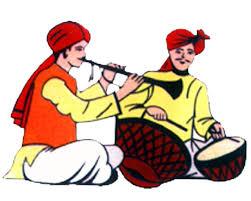
In the past, the shehnai was part of the naubat or traditional ensemble of nine instruments found at royal courts.
Ensembles (pronounced ‘onsomble’): things (here, instruments) considered as a group
The
shehnai was a part of the naubat. (Naubat is an urdu word and it means
traditional ensemble that means a traditional group of nine musical
instruments.) These nine musical instruments were played at the royal
court and shehnai was also a part of naubat.
Till
recently it was used only in temples and weddings. The credit for
bringing this instrument onto the classical stage goes to Ustaad
Bismillah Khan.
The
shehnai was played at the king’s court, in temples and at weddings. It
was used on stage in performances and the credit for that goes to Utsad
Bismillah Khan who was a legendary shehnai player and people wanted to
hear him play the shehnai.
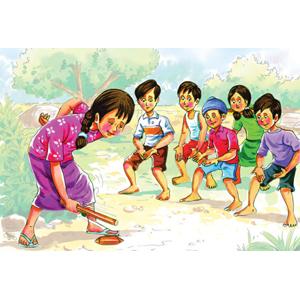
As a five-year old, Bismillah Khan played gilli danda near a pond in the ancient estate of Dumraon in Bihar.
When
Bismillah Khan was five years old, he lived in an old estate named
Dumraon in present day Bihar estate. He used to play gilli danda, an old
sport quite similar to cricket.
He
would regularly go to the nearby Bihariji temple to sing the Bhojpuri
‘Chaita’, at the end of which he would earn a big laddu weighing 1.25
kg, a prize given by the local Maharaja.
Laddu or laddoo are sphere-shaped sweets originated in the Indian subcontinent.
Also,
he would go to the nearby Bihariji temple. Although Bismillah Khan was a
muslim, he would go to the temple and he would sing this song –
‘Chaita’ in Bhojpuri language. (Bhojpuri language is spoken in an area
of Bihar.) When he would finish reciting the song, he would get a big
laddu as reward and the weight of that laddu was 1.25 kg. This was a
prize given to Bismillah Khan by Local maharaja for singing the chaita.
This happened 80 years ago, and the little boy has travelled far to earn the highest civilian award in India — the Bharat Ratna.
The
writer says that this incident occurred when Bismillah was five years
old, that he would get this Laddu as a reward. And after Eight years,
Bismillah Khan earned the highest civilian award in India - the Bharat
Ratna. So, this is the distance that he has travelled in his life. At
five years of age, he would get a 1.25 kg laddu as a reward and at
eighty, he achieved the highest civilian award in India that is the
Bharat Ratna.
Born on 21 March 1916, Bismillah belongs to a well-known family of musicians from Bihar.
Bismillah Khan was born on 21 March 1916 in a family of Musicians in Bihar.
His grandfather, Rasool Bux Khan, was the shehnai-nawaz of the Bhojpur king’s court. His father, Paigambar Bux, and other paternal ancestors were also great shehnai players.
paternal ancestors: ancestors of the father
The
lineage on his father’s side was full of great shehnai players. We can
say that Bismillah Khan ji acquired the skill of playing the shehnai
from his ancestors. His grandfather was a great shehnai player. He
played the shehnai in the court of the Bhojpur king. His father and all
paternal ancestors were also great shehnai players.
That's all for today!!
Classwork- Explanation of the lesson
Homework-Word meanings in literature copies (given in blue)
That's all for today!!
Classwork- Explanation of the lesson
Homework-Word meanings in literature copies (given in blue)





mam do we have to write the word meaning only
ReplyDeleteYes
DeleteMa'am do we have to write the chapter explanation also
ReplyDeleteOnly word meanings
DeleteThank you ma'am
DeleteThank u ma’am for the information
ReplyDeleteClearly mentioned that we have to write wordmeawords only and explanation is to be read
ReplyDeleteThank You Mam
ReplyDeleteThis comment has been removed by the author.
ReplyDeleteMa'am , these are the names for the 'spin a yarn' competition-
ReplyDelete1. Advait Mohanty
2. Aditya Narayan
3. Arjav Jain
4. Karan Kapoor
5. Kenn John Mathew
This comment has been removed by the author.
DeleteThanks Advait.. No. 1 is the group leader?
Deleteyes ma'am.
DeleteGood morning mam I am Kritik Kuraria
ReplyDeleteThis comment has been removed by the author.
ReplyDeleteGood morning ma'am. Samarth Raj 9D
ReplyDeleteThis comment has been removed by the author.
ReplyDelete